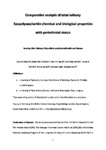Comparative analysis of total salivary lipopolysaccharide chemical and biological properties with periodontal status
| dc.contributor.author | Mcilwaine, Clare | |
| dc.contributor.author | Strachan, Alexander | |
| dc.contributor.author | Harrington, Z | |
| dc.contributor.author | Jerreat, M | |
| dc.contributor.author | Belfield, Louise | |
| dc.contributor.author | Sandor, V | |
| dc.contributor.author | Foey, Andrew | |
| dc.contributor.author | Zaric, Svetislav | |
| dc.date.accessioned | 2020-07-09T11:48:48Z | |
| dc.date.issued | 2020-02 | |
| dc.identifier.issn | 0003-9969 | |
| dc.identifier.issn | 1879-1506 | |
| dc.identifier.other | 104633 | |
| dc.identifier.uri | http://hdl.handle.net/10026.1/15929 | |
| dc.description.abstract |
OBJECTIVE: Clinical manifestations of Gram-negative bacteria mediated diseases can be influenced by how the host senses their major microbe-associated molecular pattern, the cell wall lipopolysaccharide (LPS). Keystone periodontal pathogens can produce a heterogeneous population of LPS molecules, with strikingly different host-microbiome interactions and immune outcomes. DESIGN: Structure-function correlations of salivary LPS extracts in patients with periodontitis before and after periodontal treatment and healthy volunteers were analysed by comparing its lipid A and carbohydrate chain chemical structure and evaluating its endotoxin activity and inflammatory potential. RESULTS: Salivary LPS extracts from periodontitis patients were characterised by high m/z lipid A mass-spectrometry peaks, corresponding to over-acylated and phosphorylated lipid A ions and by a combination of rough and smooth LPS carbohydrate moieties. In contrast, gingival health was defined by the predominance of low m/z lipid A peaks, consistent with under-acylated and hypo-phosphorylated lipid A molecular signatures, with long and intermediate carbohydrate chains as determined by silver staining. Total, diseased salivary LPS extracts were stronger inducers of the recombinant factor C assay and triggered significantly higher levels of TNF-α, IL-8 and IP-10 production in THP-1 cells, compared to almost immunosilent healthy samples. Interestingly, salivary LPS architecture, endotoxin activity, and inflammatory potential were well conserved after periodontal therapy and showed similarities to diseased samples. CONCLUSIONS: This study sheds new light on molecular pathogenic mechanisms of oral dysbiotic communities and indicates that the regulation of LPS chemical structure is an important mechanism that drives oral bacteria-host immune system interactions into either a symbiotic or pathogenic relationship. | |
| dc.format.extent | 104633-104633 | |
| dc.format.medium | Print-Electronic | |
| dc.language | en | |
| dc.language.iso | en | |
| dc.publisher | Elsevier BV | |
| dc.subject | LPS | |
| dc.subject | saliva | |
| dc.subject | Periodontitis | |
| dc.subject | Lipid A | |
| dc.subject | Host-microbiome interactions | |
| dc.title | Comparative analysis of total salivary lipopolysaccharide chemical and biological properties with periodontal status | |
| dc.type | journal-article | |
| dc.type | Journal Article | |
| plymouth.author-url | https://www.webofscience.com/api/gateway?GWVersion=2&SrcApp=PARTNER_APP&SrcAuth=LinksAMR&KeyUT=WOS:000523654000004&DestLinkType=FullRecord&DestApp=ALL_WOS&UsrCustomerID=11bb513d99f797142bcfeffcc58ea008 | |
| plymouth.volume | 110 | |
| plymouth.publication-status | Published | |
| plymouth.journal | Archives of Oral Biology | |
| dc.identifier.doi | 10.1016/j.archoralbio.2019.104633 | |
| plymouth.organisational-group | /Plymouth | |
| plymouth.organisational-group | /Plymouth/Faculty of Health | |
| plymouth.organisational-group | /Plymouth/Faculty of Health/Peninsula Dental School | |
| plymouth.organisational-group | /Plymouth/Faculty of Science and Engineering | |
| plymouth.organisational-group | /Plymouth/REF 2021 Researchers by UoA | |
| plymouth.organisational-group | /Plymouth/REF 2021 Researchers by UoA/UoA01 Clinical Medicine | |
| plymouth.organisational-group | /Plymouth/REF 2021 Researchers by UoA/UoA01 Clinical Medicine/UoA01 Clinical Medicine | |
| plymouth.organisational-group | /Plymouth/Research Groups | |
| plymouth.organisational-group | /Plymouth/Research Groups/Institute of Translational and Stratified Medicine (ITSMED) | |
| plymouth.organisational-group | /Plymouth/Research Groups/Institute of Translational and Stratified Medicine (ITSMED)/CBR | |
| plymouth.organisational-group | /Plymouth/Users by role | |
| plymouth.organisational-group | /Plymouth/Users by role/Academics | |
| dc.publisher.place | England | |
| dcterms.dateAccepted | 2019-12-10 | |
| dc.rights.embargodate | 2020-12-12 | |
| dc.identifier.eissn | 1879-1506 | |
| dc.rights.embargoperiod | Not known | |
| rioxxterms.versionofrecord | 10.1016/j.archoralbio.2019.104633 | |
| rioxxterms.licenseref.uri | http://www.rioxx.net/licenses/all-rights-reserved | |
| rioxxterms.licenseref.startdate | 2020-02 | |
| rioxxterms.type | Journal Article/Review |


